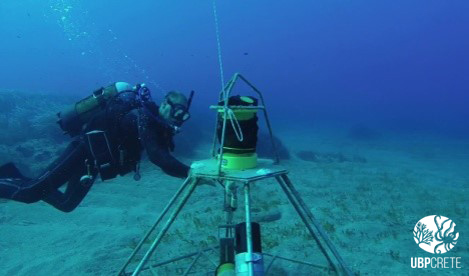

The Seafloor Observatory of UBPCrete is a single installation deployed at a depth of 20m. The observatory is a multiparametric platform equipped with sensors for the continuous measurement of sea temperature, salinity, density, sound velocity, dissolved oxygen (CTD), in-vivo chlorophyll-a, turbidity, fluorescence (Fluorometer), sea currents velocity/direction in the water column and waves velocity and height (bottom moored ADP). Coupled with the physical oceanography data real-time meteorological measurements of temperature, humidity, wind speed and direction, barometric pressure, precipitation, total solar radiation, photosynthetically active radiation (PAR), UVA – UVB radiation are taken from a meteorological station located at the IMBBC land premises.
Seafloor observatory components:
Seafloor observatory components:

The UBPCrete seafloor observatory addresses its scientific objectives in increasing our knowledge on the low-frequency processes in terms of physical and biological parameters occurring on the inner shelf of the northern coast of Crete which is exposed to the wave action. Major research priorities include the support of experimental and demonstration R&D activities with specific emphasis on research for the protection and the integrated management of the coastal environment, the sustainable exploitation of coastal biological resources, applied research related to the construction and deployment of artificial habitats technologies.

The deployment of a cable composed of various single-mode optical fibers and a central copper conductor tube for the continuous transmission of data and power from and to the deployed instruments of the observatory is in the design phase. The ability to get real-time data from the UBPCrete seafloor observatory is expected to make a major contribution for the long term monitoring of the local coastal ecosystem and will offer support to various experimental and educational activities including the implementation of a broad spectrum of Citizens’ Science projects.